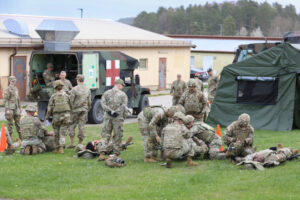
Story by Rachel Herrod
U.S. Army Medical Department Activity Bavaria
HOHENFELS, Germany — U.S. Army Health Clinic Hohenfels conducted a mass casualty training exercise on Thursday, April 17, 2025, to strengthen medical readiness and sharpen emergency response capabilities in a simulated large-scale combat operations environment.
More than 30 participants took part in the hands-on event, including medics, clinic providers, medical staff, and volunteers. The scenario tested essential battlefield medical tasks such as triage, patient movement, tactical combat casualty care, and medical evacuation, all under the stress of a notional attack that produced 15 simulated casualties.
“Mass casualty training equips military medical personnel with the essential skills and decision making abilities required to effectively manage mass casualty incidents,” said Maj. Curtis Mills, the exercise’s officer in charge and chief medical officer at U.S. Army Health Clinic Hohenfels. “This includes an emphasis on coordinated teamwork and cohesiveness, tactical combat casualty care, the rapid triage and prioritization of casualties, providing life-saving interventions, and medical evacuation.”
In alignment with the Army’s focus on large-scale combat operations, the training pushed participants to respond with urgency while coordinating limited resources. Role players with simulated injuries enhanced the realism of the scenario. Each casualty was assessed, triaged based on injury severity, and stabilized in one of three medical treatment bays before being prepped for evacuation.
“Heightened global tensions and the strategic importance of U.S. forces in Europe necessitate a readiness posture prepared for large-scale conflicts,” Mills said. “Consequently, it is essential that military medical personnel are fully prepared to manage a potentially high volume of casualties in a resource-constrained environment.”
The event also allowed medical staff from the clinic to train side by side with personnel from the U.S. Army Dental Clinic Hohenfels and 1st Battalion, 4th Infantry Regiment. This collaboration allowed participants to practice joint operations and build working relationships between units that may share responsibilities in a real emergency.
“Exercises like this give our Soldiers and providers the chance to build on their operational medical skills,” said Sgt. 1st Class Nathanael Lane, detachment sergeant at U.S. Army Health Clinic Hohenfels. “They also help our staff understand the systems in place before patients arrive from forward areas, so they are better prepared to treat them or support training for other deployed teams.”
For newer medical professionals, the opportunity to learn alongside experienced teammates was a highlight.
“Everyone around me is so skilled and knowledgeable. They move so fast, and I’m still learning. That was the most challenging part for me,” said Spc. Gabriela Jaramillo, a combat medic with 1st Battalion, 4th Infantry Regiment. “But being surrounded by that kind of experience helps me grow. These types of scenarios let me learn by doing, and I get to absorb the expertise of people who really know what they’re doing.”
Spc. Austen Perez, a radiology technician at U.S. Army Health Clinic Hohenfels, noted that even tasks outside his usual specialty provided meaningful learning opportunities.
“Today I really got to work on loading and unloading patients from the field litter ambulance, which was a great hands-on experience,” Perez said. “It was good practice to work as a team, using clear communication to move patients to the right triage point and stay calm in a stressful situation.”
Observer coach trainers from JMRC guided participants throughout the exercise and provided feedback in a structured after-action review. Their input will help shape future drills and ensure the clinic team continues to improve and adapt.
Training events like this underscore the importance of being medically ready. Exercises like these ensure that Army medicine remains agile, capable, and prepared to meet mission requirements at every level.